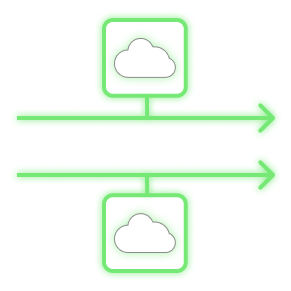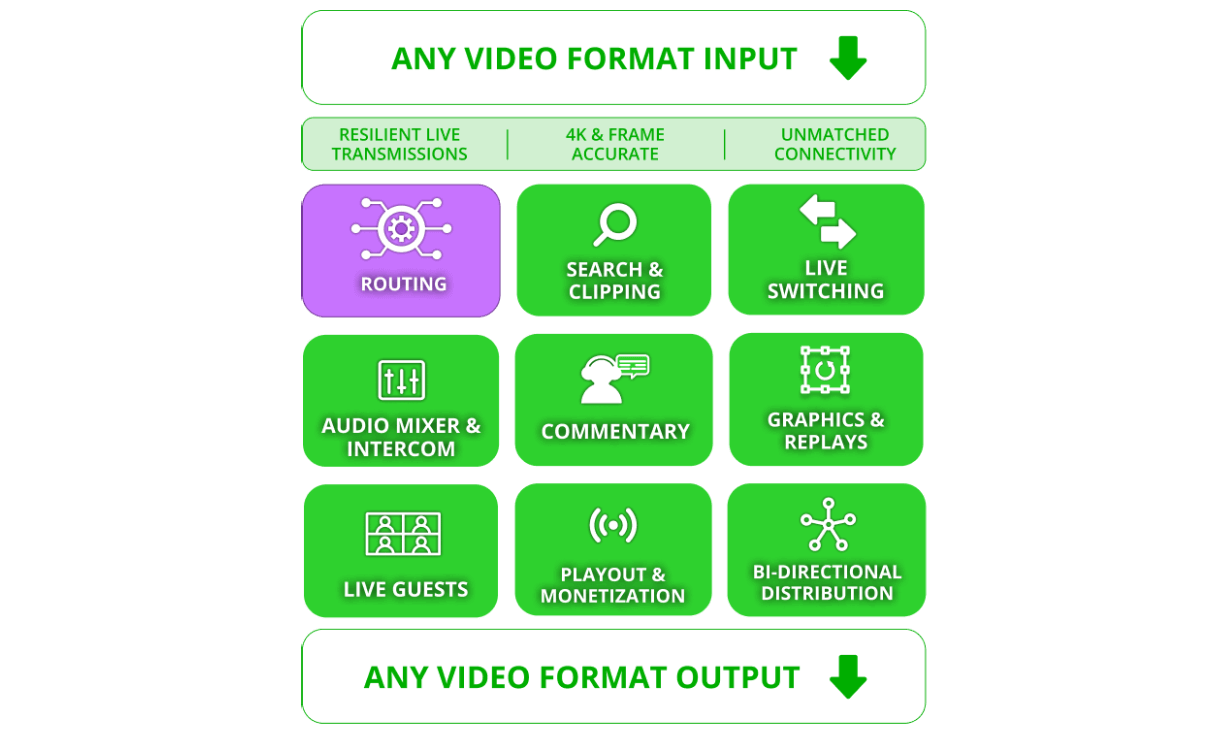
Universal encoder, decoder and receiver
Manage and distribute all your streaming signals with a click
Your all-in-one router and receiver for effortless, high-quality distribution. Manage unlimited signals —RTMP, RTSP, HLS, SRT, and more—with no additional hardware and no training required.
Goodbye hardware limits! Unlock unlimited outputs
Traditional receivers are costly and limit outputs and signal types. TVU MediaHub™ runs in the cloud, letting you manage unlimited inputs and outputs right from your computer. It automatically encodes, decodes, and scales any streaming or broadcast format—RTMP, RTPS, SRT, HLS, SDI, and more—so you can focus on your content!

Drag. Drop. Done.
Converting signals has never been easier.
With real-time previews and a simple drag-and-drop interface, distributing content has never been easier. Say goodbye to tangled hardware and compatibility issues. With TVU MediaHub, your receiver is always on and accessible.
Enjoy full compatibility
TVU MediaHub is the bridge for all the hardware, software, and digital components in your streaming workflow, allowing you to route any audio, video, or metadata formats with ease. Seamlessly integrate all assets in just a few clicks.
Flawless Performance:
No more glitches
Built in collaboration with broadcast industry leaders, TVU MediaHub meets the highest standards of reliability and speed. Manage unlimited signals in real-time with zero latency and unmatched stability—no more lag, stuttering, or on-air glitches. Seamless content flow guaranteed!
So much more than a router and receiver
- Scheduling
- Recording
- Analytics
- Redundancy
Scheduling
Plan and automate your routing operations in advance, ensuring timely content delivery without the stress of last-minute coordination.

Recording
Instantly capture live feeds for archival, review, or rebroadcast, ensuring no important broadcast moment is missed.

Analytics
Analytics dashboard delivers real-time insights into your routing usage and efficiency. Monitor bandwidth, analyze signal flows, and make data-driven decisions to optimize your network.

Redundancy
Crafted with redundancy at its core, offering backup paths for every signal. In the rare event of a disruption, an alternative path activates immediately, ensuring your video and audio flow remains continuous for non-stop broadcasting.

Accessible Pricing:
Pay as you Go
Choose a cost-effective solution that grows with you. With TVU MediaHub, there’s no need for large upfront investments. Pay only for what you use, with pricing based on inputs, outputs, and managed resources, allowing you to scale up or down as needed.
Step into TVU's universe:
Addressing any media workflow challenges.
TVU MediaHub™ is your gateway to our complete broadcast ecosystem. Bridging digital and on-premises workflows. From AI-powered ingesting, clipping and playout to sophisticated graphics and efficient ad management, our tools address the full spectrum of media supply chain challenges, for a unified and powerful broadcasting experience.

FAQ
What are the main differences between RT, RTMP, RTSP, and SRT receivers for live streaming, and how do I choose the right one?
RTMP is ideal for low-latency streaming to Flash players and interactive streaming but lacks HTTP compatibility, making it best for internal feeds.
RTSP allows real-time control over IP camera feeds, often used in security and low-latency, closed network applications.
SRT is highly secure with low latency, using advanced error correction, making it suitable for live broadcasts over unreliable networks.
RT offers foundational real-time control but lacks modern latency optimizations.
Choosing the Right One: SRT is generally preferred for high-quality public streaming, while RTSP is best for IP camera setups. RTMP remains viable for private, low-latency broadcasts. TVU Mediahub supports all formats, providing flexible routing for diverse streaming needs.
How do I set up an RTMP receiver for live streaming, and what are the best practices?
To set up an RTMP receiver, configure your streaming software to push RTMP data to the desired server, then connect the receiver to this feed.
Best Practices: Ensure minimal bandwidth fluctuations, use adaptive bitrate settings if possible, and limit RTMP use for short-latency streams. With TVU Mediahub, you can streamline RTMP input configuration, making it more resilient to connection inconsistencies.
How can an SRT receiver improve video quality over unstable networks, and what configurations help reduce latency?
SRT receivers enhance video stability by using error correction (ARQ) and encryption. Configuring a shorter buffer, adjusting latency settings, and fine-tuning retransmission intervals can help.
TVU Mediahub’s SRT receiver setup automatically optimizes these settings, allowing for seamless, high-quality streaming on unstable networks.
What is the role of RTSP receivers in live streaming workflows, and how do they integrate with IP cameras?
RTSP receivers decode real-time streams from IP cameras, giving operators control over live video. They’re commonly used in surveillance and live event monitoring.
Integration requires configuring the camera’s RTSP stream URL into the receiver software. TVU Mediahub makes it easy to route and manage RTSP feeds, allowing seamless integration with other protocols.
What are the top SRT receiver software options available, and are there any open-source solutions?
Popular SRT receiver options include OBS Studio, Haivision Play Pro, and VLC Media Player. Open-source choices like OBS are highly customizable, and VLC supports SRT decoding for various workflows.
TVU Mediahub offers a robust cloud solution with SRT support, ideal for broadcasters requiring scalable, real-time applications.
How can I configure an RT receiver to work with different streaming protocols, including RTSP and SRT?
Configuring an RT receiver for protocol flexibility involves using multi-protocol decoding software or hardware that accepts input from different sources.
Most high-quality receivers support RT, RTSP, RTMP, and SRT with appropriate configuration. TVU Mediahub provides protocol-agnostic routing, making it the ideal solution for hybrid streaming environments.
How do I troubleshoot common connectivity issues with RTMP and RTSP receivers in a streaming setup?
Common issues include firewall restrictions, network latency, and protocol mismatches.
For RTMP, ensure firewall compatibility and consistent bandwidth; for RTSP, verify correct IP camera URLs and network permissions. TVU Mediahub’s interface offers built-in troubleshooting for connection monitoring and diagnostics.
Are there differences between using hardware and software SRT receivers, and which is better for high-quality streaming?
Hardware SRT receivers often provide lower latency and more stable connections but lack flexibility.
Software receivers, such as VLC or OBS, offer adaptability and lower cost but can suffer from processing delays on low-end devices.
TVU Mediahub’s cloud solution offers the best of both worlds, with high-quality, real-time decoding and flexible protocol handling.
How can I connect an RTSP receiver to HDMI for display on monitors, and what equipment is needed?
Connecting an RTSP receiver to HDMI requires a decoder that converts RTSP input to HDMI output. HDMI decoders for RTSP are widely available, but TVU Mediahub simplifies this process by supporting RTSP-to-HDMI output natively, eliminating the need for extra hardware.
What are the best practices for securing RT, RTMP, and SRT receivers to ensure stable, high-quality streaming?
Best practices include using secure networks, encrypting streams (especially for SRT), and monitoring bandwidth stability. Firewalls should be configured to allow necessary ports.
TVU Mediahub provides encryption and robust security settings, ensuring stable, protected streams across all supported protocols.